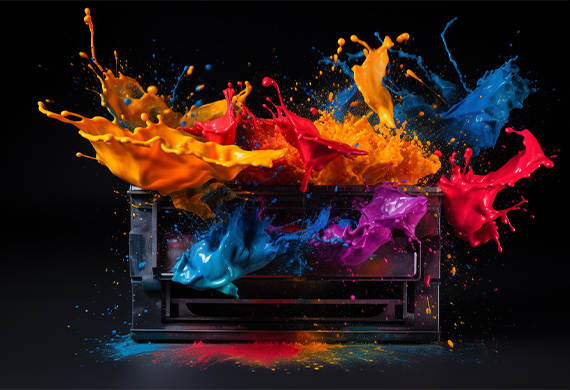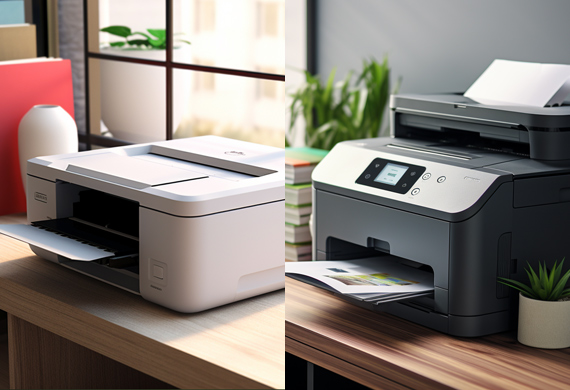Recent Posts
- Home
- Printing & Design Tips
- Understand How Printing Ink is Made and Manufactured
Understand How Printing Ink is Made and Manufactured
Posted by on

Have you ever wondered about the colorful and vibrant world of printer ink? Creating this essential component for our newer printers is a fascinating journey combining art, science, and technology. In this Clash Graphics blog post, we will explore how printing ink is manufactured, the various types of given ink, the comparison between inkjet and laser printers, the environmental impact, sustainability, and the importance of quality control and testing. Let's dive into the world of ink and uncover its secrets!
Short Summary
Printing ink is manufactured by combining pigments, dyes, binders, solvents, and additives.
Different types of printer inks are available for various applications. Pigment-based inks offer greater water resistance and lightfastness (its resistance to fading upon exposure to light) compared to dye-based ones.
Quality control and testing ensure the ink meets necessary standards while adhering to safety regulations.
The Basics of Printing Ink Manufacturing

Printing ink is a versatile substance that serves as the lifeblood of our printers, allowing them to create vivid images and text on paper. Composed of pigments and dyes, binders and solvents, and additives to modify physical properties, printing ink has evolved to meet the demands of various printing processes and technologies.
Ink formulas and manufacturing involve combining these components in the right proportions to achieve the desired properties, such as color, viscosity, and drying time. The process begins with selecting pigments and dyes, which provide the ink with its color.
Next, binders and solvents are chosen to give the ink its necessary characteristics, such as strength, flexibility, and resistance. Finally, additives are incorporated to modify physical properties, such as gloss, intensity, and heat or water resistance.
Pigments and Dyes
Pigments and dyes are the essential ingredients that give printer ink its vibrant colors. Pigments are salts and nitrogen-containing compounds, while dyes are soluble colorants that dissolve in liquid. These substances are blended into varnish and then pulverized to disintegrate any lumps, ensuring the colors are uniformly dispersed throughout the ink.
In printing ink, inorganic pigments such as Chrome Green (Cr2O3), Prussian Blue (Fe4[Fe(CN)6]3), Cadmium Yellow (CdS), and molybdate orange are commonly used. Ballpoint pen paste is a commonly used writing instrument. It contains roughly 40-50% dye in its composition.
Binders and Solvents
Binders and solvents play a crucial role in the ink manufacturing process. Binders are responsible for the surface appearance, strength, flexibility, and resistance properties of the ink, while solvents dissolve the binders and facilitate their combination with other ink components.
Various polymer and resin types are used as binders in inks, while common solvents include organic compounds such as hydrocarbons and alcohols. Dispersants are added to facilitate ink flow and stabilize pigment particles, reducing the mechanical energy required for grinding. Surfactants and polymers are typically used for this purpose and are suspended in a solvent.
Additives
Additives are substances added to a product to enhance or alter its characteristics and are commonly used in ink production. In the context of printing ink, additives are used to modify the physical characteristics of the ink, such as improving its gloss, intensity, and heat or water resistance.
The use of additives allows manufacturers to tailor the properties of the ink to accommodate different requirements, ensuring that the ink performs optimally in various printing processes and on different substrates.
Types of Printer Inks

Printer inks can be broadly categorized into pigment-based and dye-based inks. Each type of ink has unique properties and applications, with some printers even utilizing a combination of both ink types for optimal performance.
Printer ink is created like paint. Colored dyes are mixed into a liquid base. The base ingredient is typically oil, such as linseed oil, soybean oil, or a petroleum distillate. Basic black ink is made by mixing carbon black and varnish. Colored ink is created using dyes or compounds like peacock blue, yellow lake, diarylide orange, and phthalocyanine green. To adjust color shading, titanium dioxide and white pigments are added.
In addition to standard inks used to produce text and graphics, there are specialty inks designed for specific applications, such as printing on fabrics, plastic, or metal. Understanding the differences between these types of printer inks can help you make informed decisions when purchasing ink cartridges or choosing a printer that best suits your needs.
Let's delve deeper into the characteristics of pigment-based, dye-based, and specialty inks.
Pigment-Based Inks
Pigment-based inks consist of tiny particles of pigment suspended in a liquid medium. Traditional pigment-based ink cartridges typically feature a 4-ink design, including cyan, magenta, yellow, and black inks.
The key difference between pigment-based and dye-based inks lies in their composition. Dye-based inks contain colorants dissolved in liquids, while pigment-based inks have a unique composition. They consist of fine powder particles suspended in a liquid. This unique composition gives pigment-based inks certain advantages, such as better water resistance and lightfastness (resistance to fading upon exposure to light), making them a popular choice for printing high-quality images and graphics.
Dye-Based Inks
Dye-based inks are composed of a combination of water, dyes or pigments, and additives. These inks are commonly used in standard desktop inkjet printers and typically require the replacement of blue (C), red (M), yellow (Y), and black ink (K) cartridges.
To achieve optimal performance when using dye-based colored inks, it is advised to use genuine OEM inks. These inks are specifically formulated to ensure the best print quality and longevity, whereas buying cheap cartridges may reduce image quality and printer performance.
Specialty Inks
Specialty inks are designed to produce distinctive effects or cater to specific printing needs. These inks can create unique finishes such as suede, reflective, puff, metallic, or glow, and may also be thermochromic or photochromic.
In addition to these unique effects, specialty inks are also used for printing on unconventional surfaces like fabrics, plastic, and metal. The printed surface is critical to know before choosing your ink. By understanding the various types of specialty colored ink available, you can select the suitable ink for your specific project and unleash your creativity on diverse mediums.
Inkjet Printers vs Laser Printers

One of the main distinctions between inkjet and laser printers is the type of ink or toner they use. Inkjet printers utilize liquid ink that is sprayed onto the paper through tiny nozzles. In contrast, laser printers employ toner powder that is fused onto the paper using heat and static electricity.
This fundamental difference in ink and toner usage influences these printers' performance, cost, and maintenance. By understanding the characteristics and advantages of each type of printer, you can make informed decisions when choosing a printer that best fits your needs and preferences.
Inkjet Printers
Inkjet printers are known for their ability to produce high-resolution images and graphics, thanks to the precise application of liquid ink onto the paper. Printers usually need four color cartridges in order to print: black, cyan, magenta, and yellow. These are essential for quality printing, though black ink is often used up the fastest.
The ink used in inkjet printers has unique characteristics, such as quick drying time and excellent color reproduction. However, inkjet printers may have higher ongoing costs due to the need for frequent ink cartridge replacements, especially when buying cheap cartridges that may not last as long or provide optimal print quality.
Laser Printers
Laser printers, on the other hand, utilize toner powder, which is a very fine plastic powder that is fused onto the paper using heat and static electricity. These printers are known for their speed and efficiency, making them more suitable for printing large volumes of text.
Although laser printers may have a higher upfront cost, they usually require less frequent toner replacement, resulting in lower ongoing expenses. However, some laser printers may not be as proficient in producing high-resolution images and graphics as their inkjet counterparts.
Environmental Impact and Sustainability

The production and disposal of most printer ink and cartridges can have a significant environmental impact. By recycling printer ink cartridges and implementing sustainable ink production practices, we can help reduce this impact and promote a greener future.
In addition to recycling efforts, it is essential to consider the environmental implications of ink manufacturing and make conscious choices when selecting ink products. The following sections will explore the benefits of recycling printer cartridges and sustainable ink production practices.
Recycling Printer Cartridges
Recycling printer cartridges is an effective way to reduce waste and conserve resources. This process involves reusing or repurposing used ink or toner cartridges instead of discarding them.
There are several ways to recycle printer cartridges, such as dropping them off at kiosks in stores like Walmart, Target, and Best Buy, or sending them back to the original manufacturer. Some office supply stores also have recycling boxes or stations that accept most inkjet and toner cartridges.
By recycling your cartridges, you not only help the environment but also support the production of new products made from these recycled printer cartridges and materials.
Sustainable Ink Production
Sustainable ink production involves using eco-friendly materials, reducing waste, and minimizing the use of harmful chemicals. Water or vegetable-based inks are suitable for producing sustainable ink, as they are less harmful to the environment than petroleum-based inks.
Innovative solutions, such as algae ink and non-petroleum-based inks, are emerging as sustainable alternatives in ink production. By adopting these eco-friendly practices and actively engaging in recycling and de-inkability initiatives, the ink manufacturing industry can contribute to a greener and more sustainable future.
Quality Control and Testing in Ink Manufacturing

Quality control and testing are essential aspects of ink manufacturing, ensuring that the ink meets the necessary standards and performs optimally on press. By verifying the ink's color, viscosity, and other characteristics, manufacturers can guarantee a consistent and high-quality product.
In this section, we will explore the importance of viscosity and color consistency and the safety regulations governing the ink manufacturing industry.
Viscosity and Color Consistency
Viscosity is a measure of a liquid's thickness or resistance to flow, while color consistency is the uniformity of color in a substance. In ink manufacturing, maintaining a constant viscosity is crucial for achieving consistent color in the printed product.
Viscosity also influences ink flow and transfer, impacting the ink's overall print quality and performance on press. By ensuring that the ink has the right viscosity and color consistency, manufacturers can deliver a product that meets the expectations of printers and end-users.
Safety Regulations
Safety regulations in ink manufacturing play a vital role in ensuring the well-being of workers and consumers alike. These regulations cover various aspects of the industry, such as mill controls, general safety procedures, safe knife-changing procedures, and risk assessments of printing ink ingredients based on their hazard and exposure.
In addition to general safety regulations, specific guidelines apply to certain types of ink, such as food-grade ink. Although no specific regulations exist for ink formulations used in food packaging, food-grade ink regulations necessitate the evaluation of safety for materials, including inks.
Summary
Throughout this blog post, we have explored the fascinating world of printing inks, their manufacturing, the various types of printer inks, the comparison between inkjet and laser printers, and the importance of environmental impact and sustainability initiatives. We've also delved into the significance of quality control and testing in the ink manufacturing industry. Armed with this knowledge, you can now make informed decisions when choosing ink products and printers that best suit your needs and preferences while contributing to a more sustainable future.
Frequently Asked Questions
What are the 3 main ingredients of ink?
Ink is composed of three main ingredients: pigments, resins, and waxes. These components work together to create an ink that is vibrant, long-lasting, and suited for various applications.
Ink is used for various purposes, from printing documents to creating artwork. Choosing the correct ink for the job is important, as different inks have different properties.
What are the raw materials for ink manufacturing?
Ink manufacturing requires various raw materials, such as resins, polymers, plasticizers, dyes, conductive salts, and premicronized pigments.
These components can be supplied as powder, liquid, or chips, depending on their intended use.
How is ink traditionally made?
Ink has been traditionally made from animal or vegetable charcoal, ground with graphite to produce pigment. This pigment was then combined with binder liquids such as water to create the ink for writing and painting. The mixture was ground with a pestle and mortar to achieve a deep pigmentation.
Which is used to manufacture printer ink?
Print printer ink is typically made with oil, dyes, carbon black pigments, white pigments, and other additives. Combining these components creates the desired colors and output quality for the printer.
Clash Graphics Print Shop Atlanta Flyer Printing
2233 Peachtree Rd NE Ste 202 Atlanta, GA 30309
(678) 235-3464

